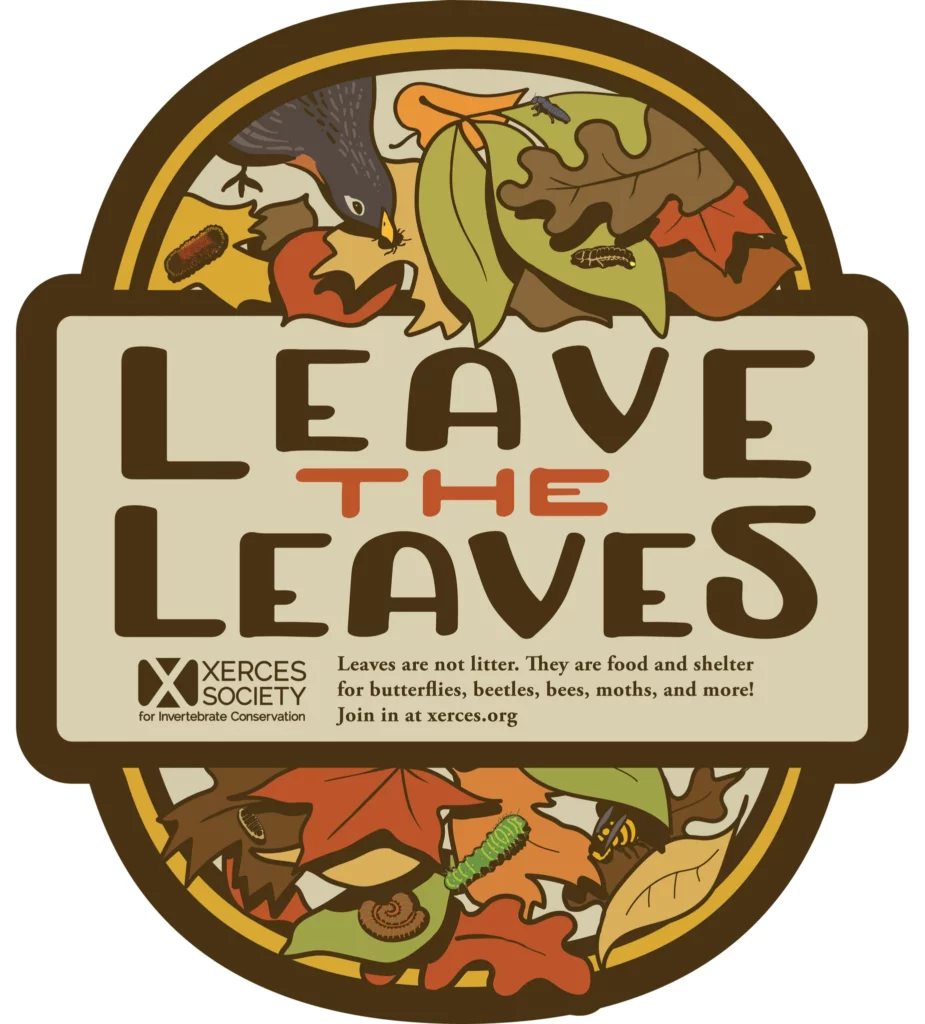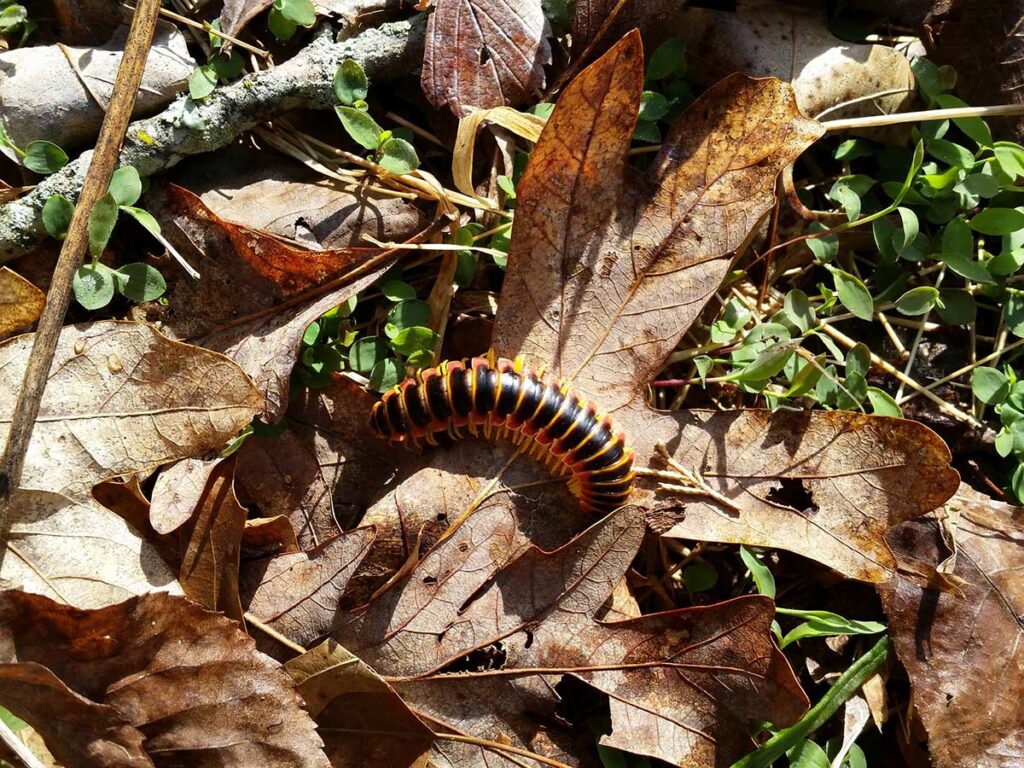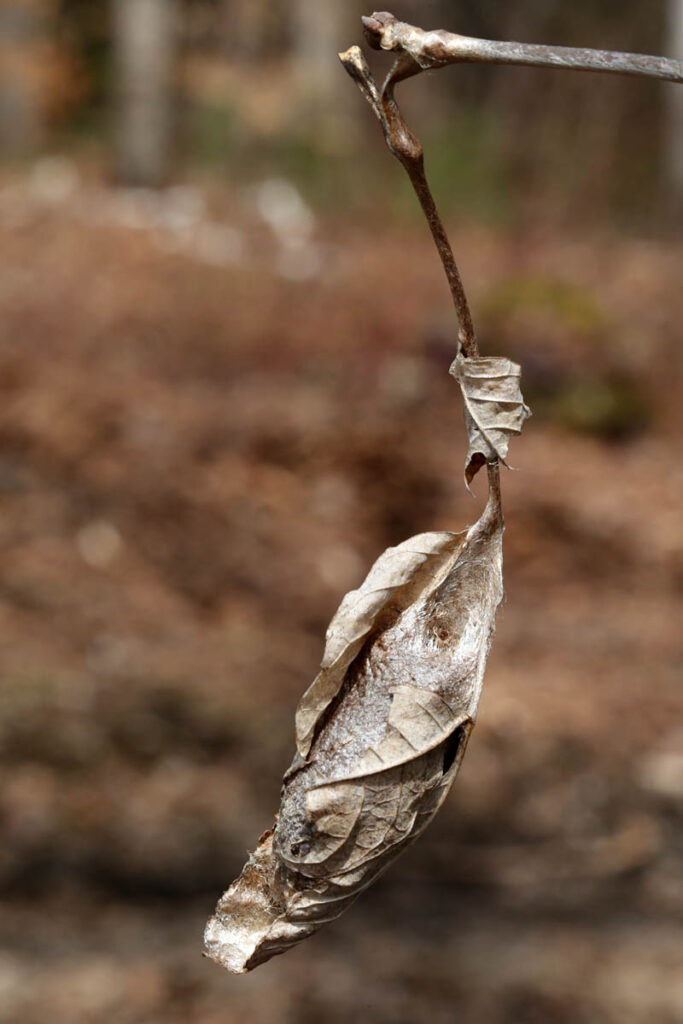LEAVE THE LEAVES
Leave the Leaves
The growing popularity of ecological horticulture reflects a shift in awareness and a desire to work with—rather than against—nature. This new approach views our gardens as ecosystems, emphasizing the relationship between plants, soil, and wildlife. It promotes sustainability by focusing on native plants, reducing chemical use, conserving water, improving soil health, and supporting biodiversity.
As autumn leaves carpet the ground, we want our yards to look tidy, and of course we should keep fallen leaves out of streets and storm drains. But the traditional approach to this problem, bagging up and hauling away leaves, is a lot of work and it’s not very sustainable. Garden cleanup is easier and more beneficial when you “Leave the Leaves.”
Leaves Are Not Litter
Leaves (along with brush piles, fallen logs, plant stems, and flower heads) play an important role in a healthy ecological cycle.
Decomposing leaves add nutrients to the soil, insulate plant roots from the cold, and provide habitat for wildlife. In fact, one of the most valuable things you can do to support pollinators and other invertebrates is to Leave the Leaves.
Gardens for the Win!
Our gardens and gardening practices are a key part of addressing problems like climate chaos and biodiversity loss. Collectively, a large number of small gardens can create a huge impact.
Leaving the Leaves improves soil; it boosts organic matter and increases soil carbon. Soil with higher carbon is more nutritious, it holds water better, is less compacted, and is better able to sequester carbon dioxide from the atmosphere.
Leaving the Leaves also provides much-needed food and habitat for wildlife. Our insect friends need places to live! Fallen leaves and garden detritus are especially valuable in urban areas. City parks, yards, and gardens provide essential habitat in areas far from the wilderness.
What Does ‘Leave the Leaves’ Actually Mean?
It means don’t bag them all up and send them to the landfill!
Rake (don’t forget to engage those core muscles!) or blow (preferably with an electric blower) whole fallen leaves to a spot where they can decompose over time, providing habitat for the little critters that will become next year’s butterflies, moths, bees, beetles, spiders, and other helpful insects.
Where Do I Put Them?
Distribute leaves as mulch throughout your garden beds, and/or push them to the back of your beds, yard, or wooded area—wherever they can break down undisturbed.
If you must leave your leaves in only one area, prioritize a spot where you’re already attracting insects, like around native plants or a pollinator garden. You could create a “soft landing” under a flowering shrub or keystone tree, so the species that live in the branches during the summer can live underneath through the winter. Pay attention to where leaves naturally accumulate and create a new bed there.
You’ll make the most impact if you transform an otherwise mowed or maintained spot, one that used to have nothing to offer overwintering insects.
How deep? Aim for a leaf layer similar to what you’d see in the woods (2-6 inches). Not too deep. Insects at the bottom of a 6-foot pile, for example, can’t breathe, sense seasonal change, or find their way out.
You can also put leaves in a pile or compost bin. A deep and/or hot compost pile will kill overwintering species, but that’s better than sending leaves to the landfill. Composted leaves are great for your garden.
Keep Making Progress
Perhaps you’ve worked hard to attract birds, bees, and butterflies to your garden. You gave them flowers and a place to nest and avoided pesticides. Throwing out all of your leaves and other plant material isn’t just taking away options for shelter; you might be tossing out animals that have already made your yard their home!
No shredding!
If you shred your leaves, you will destroy the very creatures you’re trying to help.
Start Small
Worried about losing control? Even leaving just a corner of your yard untouched can make a big difference.
Cool It on the Clean Up
With the rest of your garden cleanup, it’s OK to be a little messy! In addition to Leaving the Leaves, you can Save the Stems. This means you leave some dead flower stems intact (to provide seeds for birds) and cut others to varying heights of 8-20 inches (to provide homes for cavity-nesting insects) — and be sure to leave those stems standing through the next growing season! Both hollow and pithy stems are valuable, as are brush and rock piles, logs, and cones. The Xerces Society can teach you lots more about providing Nesting and Overwintering Habitat (PDF).
Leave ‘Em For Good
If you can, Leave the Leaves (and stems) forever. In other words: don’t be too tidy in Spring either. We used to think that most insects will have emerged once the ground hits 50°, but that’s not the case. Studies show that just as many insects emerge in July as did in May. Leaf habitat is valuable all year round.
Extra Credit
Spread the word! Encourage your friends and neighbors to Leave their Leaves too!

By the Numbers
In a square meter of yard where you Leave the Leaves, almost 2,000 insects will emerge.
This includes arboreal arthropods, which are species that spend only a portion of their lives in the fallen leaves and the rest above ground—roughly 20 butterflies and moths, 300 parasitic wasps (good guys), 400 beetles, more than 100 spiders, over 1,000 flies of various kinds—plus lots of decomposers and detritivores—like earthworms, millipedes, and tiny soil animals called springtails.

When you remove or shred the leaves, you reduce the average number of moths by 45%, spiders by 56%, and beetles by 24%. Besides those declines in abundance (the total number of individuals), species richness (the diversity within each group) is also reduced. In butterflies and moths, for example, diversity falls by about 44%. The essential ecological services these organisms perform—including pest control by spiders, parasitic wasps, and certain beetles—also plummets.

Further Reading
Xerces Society | xerces.org
The Xerces Society, an international nonprofit organization dedicated to invertebrate conservation, offers this 101 on how and why to Leave the Leaves and provide Nesting and Overwintering Habitat (PDF).
National Park Service | www.nps.gov
Did you know that our treasured National Park Service has a whole “I Didn’t Know That” series, including one on Leave the Leaves? It’s super great!
The Seattle Times | seattletimes.com
Our local paper’s take on Why Leaving the Leaves is Better for Your Yard.
Margaret Roach, A Way To Garden | awaytogarden.com
Margaret’s interview with entomologist Max Ferlauto about a recently published research study that calculates the impacts of leaf removal. Fascinating!
Heather Holm, Pollinators Native Plants | pollinatorsnativeplants.com
Bee and pollinator expert Heather Holm explains how Soft Landings provide critical shelter and habitat for our beneficial insect friends.
